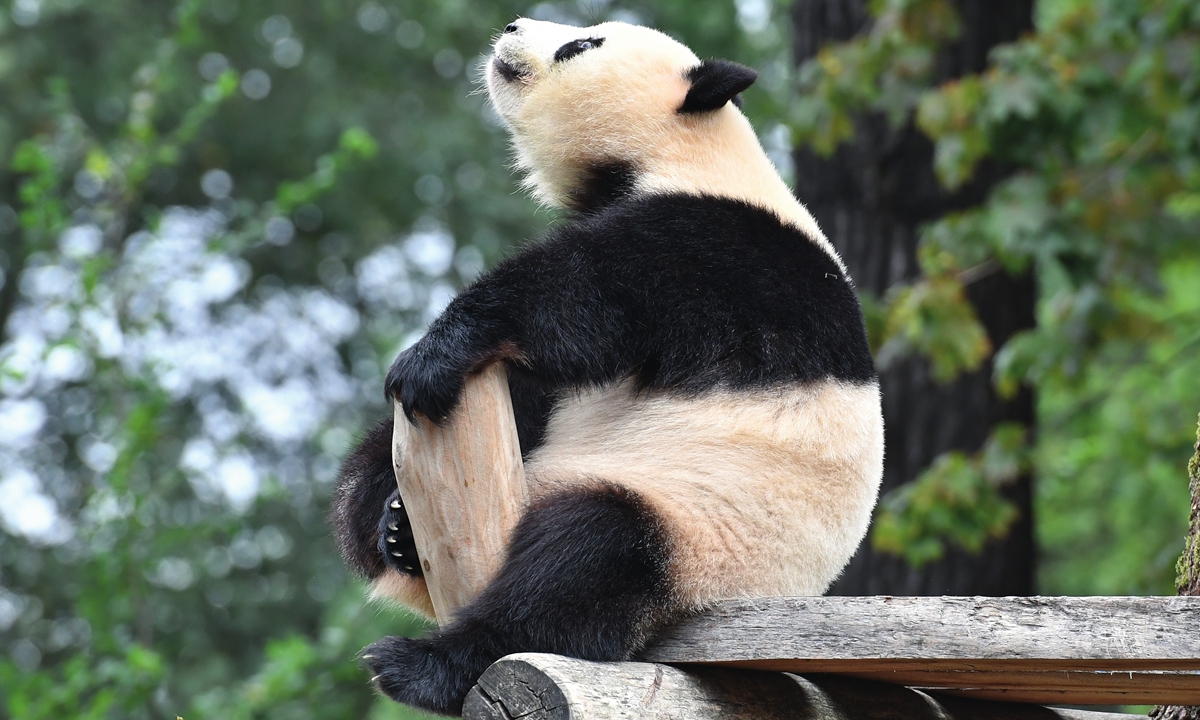Is it time to end ‘panda diplomacy’?
‘It is more than politics,’ global efforts yield in saving precious species

The giant panda Meng Meng, who was sent to Germany from China on a long-term loan, is seen playing on wood piles at Berlin Zoo on August 21, 2017.Photo: IC
The controversy over the death and the bad health of a couple of giant pandas named Le Le, 25, and Ya Ya, 23, female, living at the Memphis Zoo in the US has saddened global panda lovers and some Chinese people question whether it is time to end "panda diplomacy." But it is always more than diplomacy or using the cute animal to drive visitor numbers, experts said, noting that the giant panda on-loan practice has already been a huge impetus for global scientific cooperation to protect this precious species shared by humanity.
Amid public concern, an expert team had been sent from China to the US zoo recently and delved into Le Le's cause of realty and the health condition of Ya Ya. According to the evaluation, Le Le died of heart disease and Ya Ya remains in a stable physical condition except for hair loss caused by skin disease.
In fact, China will continue to follow up and maintain contact with overseas zoos over the condition of giant pandas in order to timely support the living of them in overseas or rectify issues identified overseas zoos. In January 2020, for example, China Wildlife Conservation Association sent a formal letter to South Korea's Everland Zoo after finding that the zoo violated the professional requirements for the protection of giant pandas as it organized performance-related personnel to have close contact with giant panda cubs during entertainment programs, requesting the zoo to immediately stop such activities, stop broadcasting or distributing the videos, and further strengthen scientific rigor.
Be-loved treasure
Since the founding of the People's Republic of China in 1949, China has given around 23 giant pandas to nine countries as a token of friendship and goodwill, according to media reports. The Chinese government put an end to the give-away policy in 1982 due to the scarcity of the species and the need for better protection of the animal.
The pandas are then offered on loan usually on cooperative research terms from China to some countries and regions, during which any resultant offspring from breeding efforts remains owned by China and sent back to China usually by four years of age for mating.
According to media reports, American zoos have to spend up to $1 million a year to rent just one of the animals. Most zoos sign a 10-year contract and would rent a couple at a time out of consideration for reproduction. And if any baby cubs are born, they pay an additional one-time $400,000 to China.
That doesn't even include extra costs like the panda's enclosure, medical care, and mountains of bamboo. Before Ya Ya and Le Le arrived in 2003, the Memphis Zoo spent $16 million to build a giant panda facility with traditional Chinese cultural elements, set up a breeding management and veterinary team, and planted about four hectares of bamboo.
In the Panda house in Doha that covers about 120,000 square meters, there is a team with some 10 experts to take care of a pair of giant pandas, Jing Jing and Sihai who started to live here in 2022. The team told media that they had learned Sichuan dialect, the language of the natural habitat of giant pandas, in order to cater to Jing Jing and Sihai's habits.
Eight hundred kilograms of fresh bamboo will be flown in each week to feed them, according to media reports.
The huge popularity of giant pandas is one of the motivations that kept driving many countries and regions to rent pandas from China despite the rocket-high fees.
Before Xiang Xiang, born in June 2017 at Ueno Zoo in Japan, returned to China on February 21, floods of panda lovers flocked to the Ueno Zoo to say goodbye to her. Admission to see the giant panda was limited to a preselected lottery of 2,600 entries a day. The final time slot on February 19 was so popular that there were around 70 times as many applicants as there were available entries.
Among the 60 on-loan giant pandas in the world, Japan reportedly owns the second largest number with nine, following the US with 11.
More than diplomacy
But loaning pandas nowadays is more than "diplomacy" or just bringing in more visitors into zoos.
The key lies in the friendly and close people-to-people exchanges at civil level between China and overseas countries and regions, Li Haidong, a professor at the Institute of International Relations at the China Foreign Affairs University, told the Global Times on Wednesday.
Considered to be a living fossil, the joint research on giant panda conservation has become a symbol of people-to-people exchanges, scientific research, and biodiversity conservation between China and other countries, which has always been valued and taken seriously by all parties, experts noted.
The fees paid to China and the incomes of the zoos via giant pandas will be poured back to the reservation of them and the overseas zoos and institutes having giant pandas would communicate and exchange techniques and experience on giant panda raising and reproduction to help make sure the valuable species survive.
During the past 10 years, the China Conservation and Research Center for the Giant Panda has set up an international and domestic cooperation and exchange platform on giant pandas, attracting 16 countries and regions to join and helping successfully breed 21 giant panda cubs overseas, the center announced in October 2022.
The number of captive giant pandas across the world reached 673, nearly double the number from a decade ago. The wild giant panda population in China has risen from 1,114 in the 1980s to 1,864, while the protected habitats for the species have also expanded significantly during the same period, according to the center.
In 2013, the Edinburgh zoo's overall income jumped by more than 5 million pounds ($5,991,250) to nearly 15 million and the number of visitors leapt by 51 percent following the arrival of Tian Tian and Yang Guang in late December 2011.
The debut of Ling Ling and Hsing Hsing at the National Zoo in Washington DC, the US, in April 1972 attracted more than 20,000 people far and wide and the number of visitors for the first month was as many as 110,000, arousing Panda-mania across the country.

